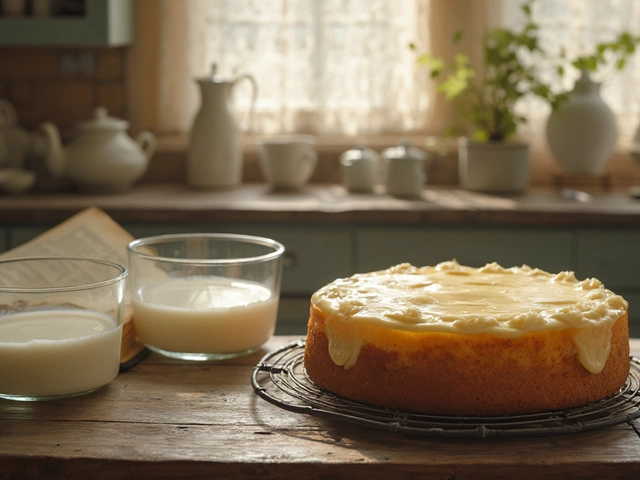
Ever tested a new fudge recipe, popped it in the fridge, and ended up with a weird, grainy brick? Happens more often than you'd think. A lot of people, especially first-time fudge makers, assume the fridge is the safest spot for anything sweet. But fudge is picky—throw it in the cold, and suddenly the smooth, creamy dream turns into a dry, crumbly letdown.
So, what’s the deal? Turns out, the fridge actually messes with the texture and flavor you worked so hard for. That chilled air sucks out moisture. Sugar crystals multiply and harden, which is why classic, homey fudge gets that gritty bite instead of melting in your mouth.
- Why Fudge Acts Weird in the Fridge
- What Happens to Fudge’s Texture
- The Science Behind Sugar and Moisture
- How to Store Fudge Properly
- When (if Ever) You Should Refrigerate Fudge
- Fixing Fudge Gone Wrong
Why Fudge Acts Weird in the Fridge
Here’s the thing: fudge isn’t like most desserts that thrive in a cool spot. Once you stash fudge in the fridge, science takes a turn. Cold air inside a fridge is designed to keep veggies crisp and milk fresh, not to protect your creamy fudge. The low temperatures cause sugar inside the fudge to crystallize. Instead of staying smooth, your fudge gets hard and crumbly, almost chalky, which nobody wants.
Why does this happen? Fudge is tricky because it depends on a delicate balance of sugar, butter, and sometimes milk or cream. When you refrigerate fudge, the moisture starts leaving the surface, and that dries it out. That sneaky bit of fridge humidity actually grabs moisture away from your sweet treat.
There’s another problem—strong smells and flavors. Fudge likes to soak up whatever’s hanging out in your fridge. Got last night’s leftover garlic pasta in there? Don’t be shocked if your fudge takes on a weird aftertaste.
- Cold temperatures = more sugar crystals (bad for smooth fudge)
- Fridge air dries out fudge and messes with softness
- Fudge absorbs odors, which ruins its flavor
And here’s something people don’t always realize: store-bought fudge is often loaded with preservatives so it holds up better. But with homemade fudge recipes, everything is super fresh, so it’s way more sensitive to temperature shifts and dampness than commercial candy.
What Happens to Fudge’s Texture
So, what actually goes down with fudge when you stick it in the fridge? The texture is the first thing to go rogue. Fresh fudge should be silky, a little chewy, and slice easily without crumbling. When you refrigerate it, two main things happen: it dries out, and it gets grainy.
Candy pros know that cold air in the fridge pulls moisture from your fudge. Once that water’s gone, you’ve got yourself a dessert brick. The creamy middle you want turns into a dense, dry chunk. And it gets worse—cold temps make the sugar in fudge re-crystallize. That’s a fancy way of saying the sugar sets up sharp edges, so your fudge feels gritty or sandy on your tongue. Not dreamy.
Compare fudge to other candies, like caramel or toffee—same deal. Sugar, moisture, and temperature are in a delicate dance. Even a couple of hours in a cold fridge make all the difference. Here’s what you might notice after refrigeration:
- The outside hardens and the inside gets crumbly.
- It loses that melt-in-your-mouth magic.
- Sometimes, you see beads of moisture on the surface after taking it out—yep, that’s sugar sweating.
This isn’t just some random opinion; it’s food science. Sugar crystals act totally different at low temps than at room temp. If you’re hoping to keep your fudge recipes perfect, the fridge is not your friend. And if you think the freezer is safer—spoiler—it’s not much better unless you’re wrapping things up tightly for months. More on that later.
The Science Behind Sugar and Moisture
The magic part of fudge is how sugar and moisture team up to make that creamy texture. When you cook fudge, you’re dissolving sugar into a hot, wet mix. As it cools, if you do everything right, the sugar forms tiny crystals—so small they melt on your tongue instead of crunching. That’s the smoothness everyone wants.
Here’s where things get dicey: moisture control is what separates dreamy fudge from a fridge disaster. Sugar loves to grab water from the air. If you store fudge in a moist fridge, it can absorb water, making it sticky. If the fridge is dry, it can suck water out of the fudge, leaving you with a stale, chalky slab.
Why is the fridge a problem? Inside a fridge, there’s a ton of shifting moisture and low temps. Both of these force sugar to “recrystallize”—which basically means the tiny sugar bits get bigger and harder, ruining that signature fudge texture. And if your fudge has dairy (like condensed milk or cream), the cold can separate the fats and liquids, leading to greasy patches or weird bubbles.
Some candy chemists have thrown fudge under the microscope and proven this. Storage below 10°C (that’s about 50°F) speeds up how quickly sugar crystals change and clump together. This change happens even faster if there are big swings in fridge humidity.
| Condition | What Happens to Fudge |
|---|---|
| Stored at Room Temp (18–22°C) | Stays creamy, texture holds up for days |
| Stored in Fridge (4°C) | Turns dry or sticky, flavor dulls |
Honestly, fudge is a bit fussy—keeping it happy means managing both sugar crystals and moisture. That’s why just tossing it in the fridge hardly ever ends well.

How to Store Fudge Properly
If you want your homemade fudge to stay creamy and delicious, room temperature is your friend. Don’t stash it in the fridge unless you absolutely have to. Here’s what you should do instead:
- Wrap it up tight: Use wax paper or parchment between layers, then cover the whole block or cut pieces in plastic wrap or aluminum foil. This keeps out air and stops the fudge from drying out or picking up weird kitchen smells.
- Pick an airtight container: Pop those wrapped pieces in a plastic container or a tin. An airtight seal stops moisture and keeps your fudge soft.
- Store at room temperature: Get this—fudge can stay fresh for 1 to 2 weeks just sitting on your counter, as long as it’s not in direct sunlight or near a heat source. If your kitchen’s super warm (over 75°F/24°C), find a cool pantry or cupboard instead.
- Freeze it for the long haul: Got more fudge than you can eat? Fudge actually freezes well. Double-wrap it and freeze for up to 3 months. To eat, let it thaw in its wrap overnight at room temperature so it doesn’t get sticky or wet.
Here’s a quick look at fudge shelf life in different storage spots:
| Storage Method | How Long It Lasts |
|---|---|
| Room Temperature (Sealed) | 1–2 weeks |
| Fridge (Sealed) | 2–3 weeks (but texture suffers) |
| Freezer (Double-Wrapped) | Up to 3 months |
One tip: always slice fudge as you go instead of all at once. Big blocks stay fresher longer, since less air sneaks in. And if you really want the absolute best taste, eat fudge within the first few days. The texture’s just right, and the flavor’s unbeatable.
When (if Ever) You Should Refrigerate Fudge
Okay, so is there ever a time when popping fudge in the fridge actually makes sense? Turns out, yes, but only in special cases. For most people, fudge is happiest at room temperature. But sometimes, you just don’t have a choice.
- Hot Weather or Humid Kitchens: If your house is warm, especially during summer or if you live somewhere tropical, fudge can melt or turn tacky. In those cases, the fridge can save your fudge recipes from becoming a sticky mess.
- Long-Term Storage: If you need to keep fudge for more than two weeks, the fridge (or even the freezer) is your backup. But remember, always wrap it tightly in plastic wrap and toss it in an airtight container to protect it from drying out and absorbing weird fridge smells.
- Cream Cheese or Perishable Add-Ins: Some creative fudge recipes use cream cheese, fresh fruit, or anything dairy-heavy. These versions absolutely need to be chilled for food safety.
Here’s a quick cheat sheet for knowing when to refrigerate:
| Situation | Room Temp | Fridge |
|---|---|---|
| Classic Butter/Sugar Fudge | ✔️ | Only if hot/humid |
| Fudge with Perishables | ✔️ | |
| Long-Term Storage (>2 weeks) | ✔️ |
If you do refrigerate, let the fudge come back to room temperature before serving. This helps it relax and get creamy again, so you don’t bite into a cold slab. Remember, the fridge is a last resort, not your go-to hiding spot for fudge.
Fixing Fudge Gone Wrong
Messed up fudge happens to the best of us—especially if it’s been in the fridge. If your batch turned out too hard, crumbly, or sticky, don’t stress. There are simple ways to save your fudge without trashing the whole pan.
If your fudge is rock hard and dry, that’s almost always from too much chilling or overcooking. The fridge zaps moisture, which leaves sugar crystals to clump up, making it feel like sweet gravel. Here’s what you can do:
- Break the fudge into chunks and put it in a microwave-safe bowl.
- Add a tablespoon of cream or milk for every cup of fudge.
- Microwave in 15-second bursts, stirring every time, until it softens and comes together.
- Pour it back into a pan, smooth it down, and let it set up at room temp—not the fridge this time.
If your fudge is sticky or won’t set, it probably needed to cook a bit longer—or maybe your humidity was high that day. But don’t panic:
- Scoop the fudge back into a saucepan.
- Gently reheat it over low, stirring constantly to avoid burning.
- Let it reach 235-240°F with a candy thermometer—the so-called "soft ball" stage.
- Take it off the heat, mix it well, and pour it into a fresh, parchment-lined pan to cool at room temp.
Sometimes, folks try to shortcut by chilling fudge or even freezing it, thinking it’ll last longer. Problem is, those super-cold spots just break down the structure and turn it grainy or sticky again once it thaws. If you need to store fudge long-term, wrap it in wax paper and keep it in an airtight container at cool room temperature. You’ll get better texture and flavor—promise.
| Fudge Problem | Quick Fix |
|---|---|
| Hard/Grainy | Microwave with milk or cream, stir smooth, reset at room temp |
| Sticky/Runny | Reheat and cook to proper temp, then reset at room temp |
| Lost Flavor | Add a dash of vanilla or melted chocolate and blend |
Once you get the basic science down, fixing fudge is way easier than most folks think. Just remember: fridge equals moisture loss, and fudge loves the stable temperatures of a pantry more than the cold. Next time, skip the fridge and go straight for a cool, airtight stash spot instead.












Write a comment